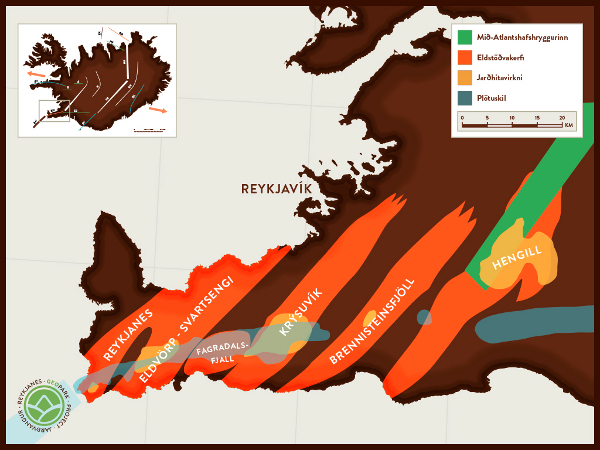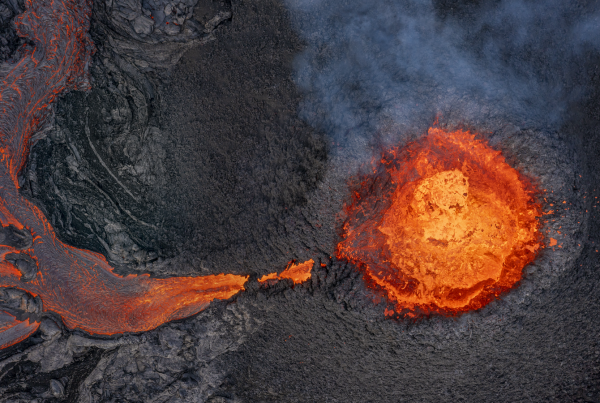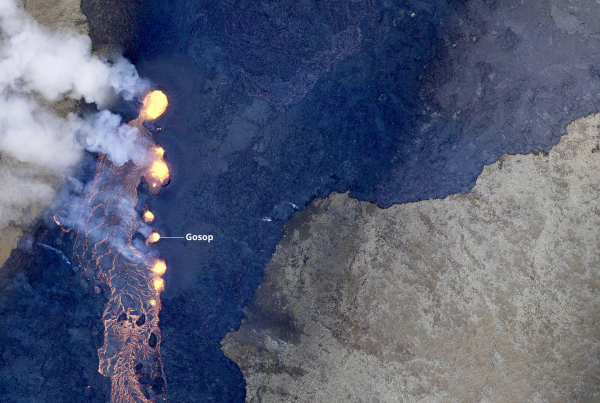Text by Ari Trausti Guðmundsson, geologist.

Volcanic systems at Reykjanes Peninsula. Photo from Reykjanes Geopark
The terrestrial unrest close to Grindavík town on the southern shore of the Reykjanes Peninsula follows a known pattern: Dilation of the crust (due to the plate drift and rifting), resulting earthquakes and an influx of magma into the crust which is about 10 km thick in this rather young part of Iceland. Similar events are known from recent history, over the past millennium, as well as at least 5,000 years back. Events without magma intrusions, or sometimes including magma injections (not breaking the surface), do occur in the four volcanic systems that have been marked across the peninsula. They line the landscape as SW-NE tending fissure swarms between the area around the Reykjanes Power Plant in the west to Mt. Hengill and the geothermal power plants at Nesjavellir and Hellisheiði in the east.
Recent events close to Grindavík
We know of recent, somewhat similar events as the one near Grindavík, for example, in the high-temperature area at the Reykjanes Power Plant in 1967 (changing the geothermal activity) and close to Mt. Hengill culminating in 1993-1998 (with a clear local inflation of the crust).
With an average interval of 800 to 1,100 years, three of the volcanic systems (VS) burst open during periods of unrest, causing a series of rather short-lived and not all too powerful lava fissure eruptions. This happened most recently in the late 10th and beginning of the 11Th century (in the VS, next to the Hengill VS), then in the 12th century (well east of Grindavík) and finally in the 13th century (Reykjanes – Svartsengi VS close to Grindavík). The Hengill VS, however, has a somewhat longer repose periods (about 2,000 years).
Geothermal plants in the vicinity of Mt. Thorbjörn
The periods of unrest in each volcanic system may last up to a few decades with long or short quiet periods between a series of eruptions in each VS. Research reveals this pattern and thus, it has been known for many decades that sooner or later we will experience volcanic eruptions in one or more of the volcanic systems on the Reykjanes Peninsula.
Three geothermal power plants were built within two VS in the light of this knowledge. Geological history indicates that events with series of earthquakes and injections of magma, but without volcanic eruptions, are much more frequent than events including an outbreak of earthly fires. Near Grindavík, over 1,300 earthquakes have been registered (up to magnitude 4.3) since Jan. 21. A 15-km-wide circular area inflates and by Feb. 6, the peak rise is 5 cm, located NW of Mt. Þorbjörn, close to the Svartsengi Power Plant. The inflation is interpreted as a crustal magma injection, a view supported by various monitoring methods. The local lava flows are associated with fissure eruptions that occurred around 800 and 2,000 years ago.
Eruption timeframe?
It is impossible to predict the future course of events near Grindavík as long as the inflation continues. It will induce further earthquake activity and might cause a volcanic fissure eruption; where and when is unclear. On the other hand, the influx of magma may end and the earthquakes abate. Everyone wishes for that most likely scenario. However, this could, after a quiet period of weeks, months or years, mean further unrest with a repeated injection of magma.
Since Jan. 22, the authorities, the Civil Protection and Emergency Management and scientific institutions have stepped up the monitoring and various preparations in face of a possible tw rolex oyster perpetual 31mm m277200 0008 ladies watch emergency situation (https://www.almannavarnir.is/english/ and https://en.vedur.is).
-Ari Trausti Guðmundsson





About the new volcano in Iceland. I have a question. About the Principle of Communicating Vessels? Is this just one volcano, or maybe two separate volcanoes?